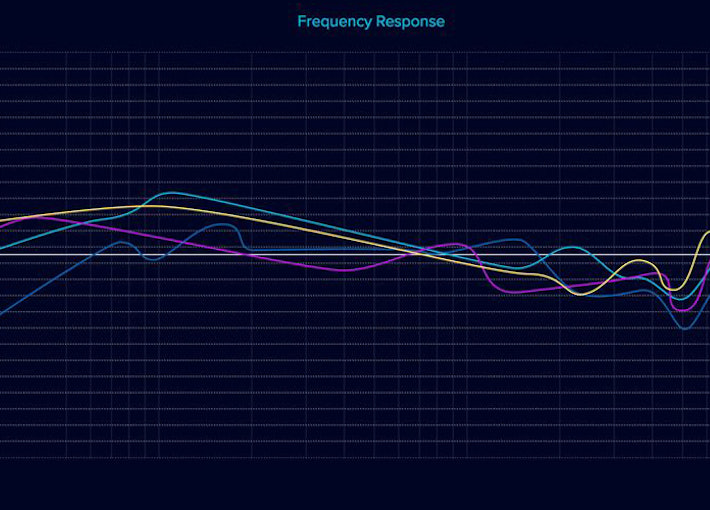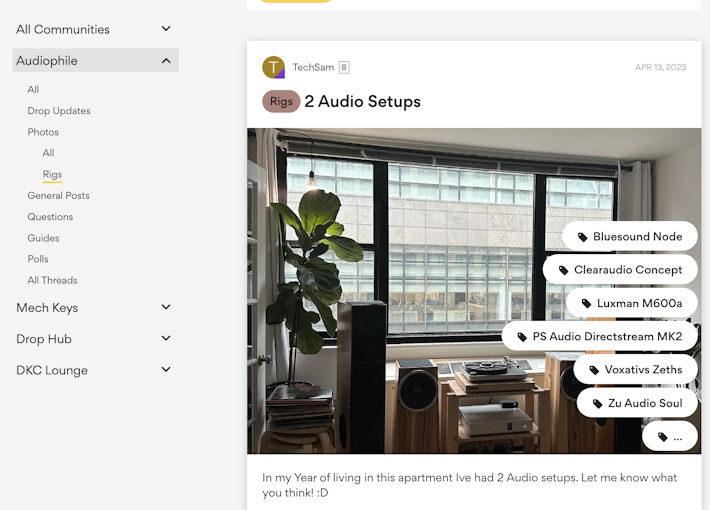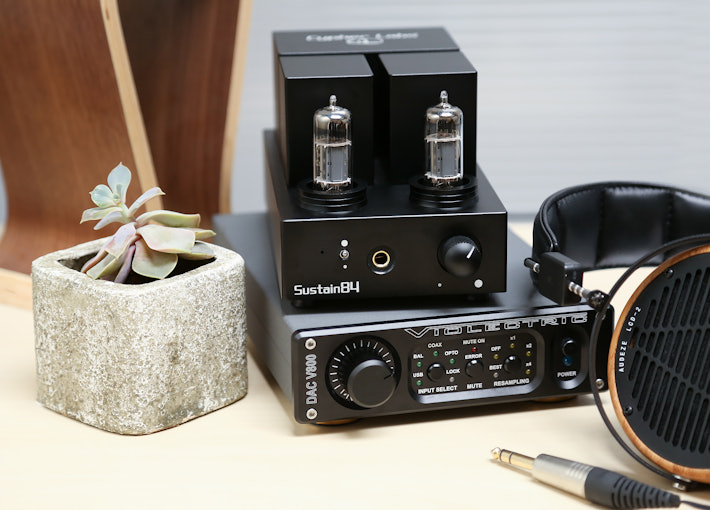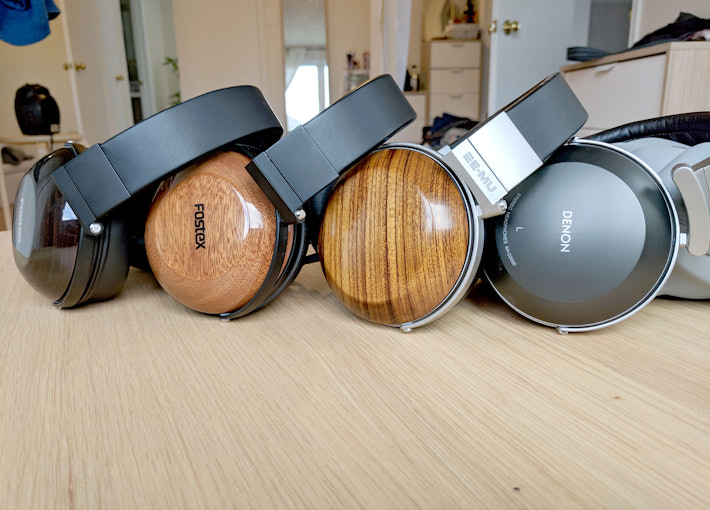Click to view our Accessibility Statement or contact us with accessibility-related questions























Audiophile

Evshrug
4076
Mar 22, 2023
push_pin
Stickied
Audiophile 101: Essential Gear Overview
Image credit @zhugunic https://drop.com/talk/67372/gl-2-k
Do I need an amp? What are these acronyms like DAC, DSP, or DSD? What even are all the components that make up an audio chain? Let’s take a beginner’s look at the core, essential building blocks of a digital audio chain, and lay it plain what each piece does. We can cover the major pieces separately, but I’ll still include a few tips to optimize playback here. Please hit the little bookmark button and feel free to check and share this guide whenever you need a reference!
For people who need a visual and audible explanation, or are worried it would take too long to get a working knowledge of the audio chain, here is my YouTube video on this subject that is just 7 minutes long! I like writing though, so let’s get started with an overview, then break it down into what each piece does and how an upgrade would benefit the final sound quality.
Signal Path
Image credit @SpeleoFool https://drop...


Evshrug
4076
Sep 12, 2020
Launch of the EvShrug Audio Guides!
Hello everyone!
I’ve been here in Drop/Massdrop for a few years, also on Head-Fi since 2008, and I’ve seen a few common questions and gaps in knowledge over the years. So, to try answering them so that I (or you) can simply link a video when a common question comes up, I “rebooted” my YouTube channel with new videos to serve as a guide for new and intermediate personal audio enthusiasts!
Thanks for accepting my amateur production with a “shrug” and a subscribe, I’ll try to upload 1-2 videos a week and add them here as well. Go ahead and leave audio questions you think others would also want answered!
YouTube Playlist:
https://www.youtube.com/playlist?list=PL4bc2SQk0h2TrE0K07t2WI5by66ArtDAb

Drop+Audiophile
3436
Jul 12, 2016
Understanding Headphone Reviews
It's All Greek to Me
As with any expensive electronic product, doing research and reading reviews on headphones is a good way to reduce the risk of buyer's remorse. Physical characteristics such as the build quality, comfort, and accessories are easily described and understood, but when it comes to describing how something sounds - that's a whole other ball game. Understanding the frequency range of sound and how it affects the music is a great running start towards understanding your own preferences and what sound signature of headphone is best for you.
When deciding what headphones are best, we have to start with frequency response.
The Spectrum of Sound
The deep rumbling of a bass guitar. The lively tweeting of a piccolo. Both of these sounds begin as vibrations, carried through the air from the instrument to your ears. As the speed of vibrations is directly correlated to pitch, the low notes on the bass guitar vibrate the air slowly as compared to the higher...

HoffmanMyster
3110
Apr 26, 2023
New Feature—Product Tagging in Photos (+ Giveaway! - Audio Rigs Edition)
Ahoy, audiophiles! Hot on the heels of the launch event for the mech keys community, we are kicking off the Audiophile Rigs product tagging launch event (with a bonus giveaway for those who participate!).
Check out all the Rigs submissions thus far! Audiophile Rigs
What’s this about a giveaway?
More details can be found at the end! The short version: we will be giving away $100 Drop Rewards credit to one lucky winner (randomly selected) from all participating users who contribute and tag their Audiophile photos using the "Rigs" flair! In order to be eligible for giveaway prizes, your photo must include at least two tagged items (not required to be Drop products—see Tagging Non-Drop Products below). Post must be made in the first two weeks (by 2023-05-10 11:59PM PT) in order to be entered.
What is Product Tagging in Photos?
Product tagging allows you to tag any products in a Photo post—both those found on Drop currently, as well as write-ins that will be manually approved and...
Bill-P
188
May 13, 2016
Headphone Modding
Hi Everybody. I’m Bill-P. You may know me from Head-Fi or SuperBestAudioFriends (formerly Changstar). I have done a lot of headphone modding in the community and have recently been doing some headphone modding for Massdrop. This led to some questions from Massdrop employees about headphone modding and why I do it. They thought you might like to know how I got into modding headphones and some of my ideas on how to mod. At the end, I’ll also share what I was able to do with the new HiFiMAN HE-350 in making them sound the way that I want them to.
Why do I modify headphones?
Basically, I really want to make headphones sound better for everyone and I think that manufacturers should hear how good their headphones can sound if they take more time to tune them. When you buy a high-end model, you expect that the manufacturer has already done all of the engineering for you- from tonality to frequency response to resolution. You assume you’re going to get great design and...

orchardaudio
100
Jan 31, 2020
How Much Amplifier Power Do I Need?
I cannot tell you the number of times I have heard a conversation about amplifier power go like this: “I hear that B&W speakers need at least 400W,” or, “I heard that Paradigm speakers are very power-hungry.”
The fact is, there IS a way to figure out how much power your speakers will need and how to pair an amplifier with the speakers you already own or are looking to purchase.
To determine the amplifier power, you will need the following items:
Speaker sensitivity specification (typically dB SPL /1W /1m)
Number of speakers you are using
Distance from speaker(s)
How loud do you want your music to sound, for general reference
70-80dB for speech only
80-95dB for light music
95-110dB for heavy music
Rules to Remember
Every time you double power or double the number of speakers, you increase the sound pressure level (SPL) by 3dB.
Every time you double the distance from the speaker, you decrease SPL by 6dB.
A speaker specification of 95 dB SPL/1W/1m means that at 1W of power, the...

Drop+Audiophile
3436
May 25, 2016
Drop 101: What Is An Amp?
Among life’s great questions—Why do we exist? What is the key to happiness? Where is the remote?—stands one that continues to vex music lovers and newcomers to the audiophile community: What is an amp?
How It Works
Lots of us might have a basic idea of what an amp does, but exactly how it functions (and the many benefits it can provide) are larger questions worth considering. The word amp is derived from the latin word amplificare, which means “to expand” or “to enlarge.” The basic function of an amplifier is to increase the power of a signal by taking energy from a power supply and converting it to a larger amplitude—therefore boosting that signal.
When sound is recorded, an electrical signal is generated through a series of vibrations and fluctuations in air pressure. First, sound waves move a microphone diaphragm back and forth, and the microphone converts that movement into an electrical signal. Then, a recorder encodes that signal as a pattern in a certain format...

Drop+Audiophile
3436
Jan 25, 2018
Brand Spotlight: Massdrop x Sennheiser
We at Massdrop have a special relationship with Sennheiser. They’re a company who believes in delivering the highest quality products to the Audiophile Community, and we’re always listening to the needs and ideas of our members so in this it's a perfect match.
Since our first collaboration with Axel Grell and the Sennheiser team, we’ve been able to come up with more ways to bring more products to the community. Starting with the HD 6XX, a Massdrop Made take on the company’s flagship headphones. The PC37X, a headset produced for competitive gaming. And now, the 58X Jubilee. Headphones tuned by Axel, and designed with feedback from the community.
Currently, Sennheiser has a team specifically dedicated to our collaborations, and this proves their commitment to always listening and to continue bringing the very best of what they can do to those who are most passionate about it.
Massdrop x Sennheiser HD 58X Jubilee Headphones
SEE DROP:
www...
giovanni23664
2
Apr 2, 2019
prodotti audio per l italia?
Come si fa a trovare i prodotti che possono essere comprati in italia?

Evshrug
4076
Oct 16, 2019
Is Bluetooth as Good as a Wired Connection?
Back when I visited CanJam NYC in 2016, I got to talking to the two founding members of Bluewave, and had an extended conversation and demo of their soon-to-release Bluetooth receiver/DAC/Amp, the GET. They argued that the quality of Bluetooth has reached a point where the internal components used had a bigger impact on the final sound quality than the fact that it was wireless, and their device would have better sound quality than the headphone jack in my smartphone. I thought this was an interesting challenge, and I had to research and rethink my perspective on Bluetooth audio.
You see, Bluetooth is a digital transmission, so it bypasses capacitance and EMI factors of headphone cables. Then, the Bluetooth receiver must then use a DSP (like a computer) to decode and decompress the transmission, a Digital to Analog Converter (DAC) and an Amplifier before outputting to the headphone transducer (speaker). When you buy a Bluetooth receiver, you’re also buying a DAC and an amp! With a...

THX Ltd.
156
Nov 21, 2018
THX Offers Online Courses to Teach How to Install the Perfect Home Theater
Want to learn how to design and install the ultimate home theater experience? THX is now offering an online Home Theater workshop designed to help both pros and amatures level-up their audio visual talents. The course includes specialized insider-knowledge of the tools and techniques to implement the latest in audio visual technology. Use the THX Professional Portal to navigate study guides, course exams, and exclusive certification resources.
Here's a special offer for our Massdrop community - save 25% if you sign up before the end of the year.

Evshrug
4076
Sep 29, 2020
Thoughts: The BEST Gaming Headphone for All Time?
Pairing up a gamer with the right headphone is a bit like playing matchmaker!
In this video, linked at the end, I boil down over 10 years of community advice into 3 Personality types:
• Competitive
• Entertainment
• Immersion
I share a few keywords to look for, as well as some software and settings suggestions. I think everyone has a little bit of each type in them, but which type is dominant for you?
Thanks to the sponsor of this video: DekoniAudio.com
Dekoni is a headphone accessories company, unique for providing frequency response graphs on their website so you know what effect their various pad options will have. Thanks also to Drop for giving me permission to share here. I hope it helps everyone!
The video:
https://youtu.be/42SRsSlIj-c

MXRC
261
Jun 3, 2018
How to: Fostex TH-X00 Detachable Cable
In light of the recent release of the Fostex TR-X00 headphones with a factory detachable cable, an update many have requested ever since the first drop, I immediately began to feel buyer's remorse and jealousy. I decided to take it upon myself to update my TH-X00 with detachable cables and bring you along through the process with pictures so that you may be better informed to endeavour if you choose to do the same.
Here's the completed assembly of what we'll be doing:
PREFACE:
It goes without saying that doing this will void any form of warranty on your headphones. Also, you could permanently damage components of the headphones. Continue at your own risk. There are a few things I would like to cover before we go ahead with the step-by-step.
Connectors: There are many types of connectors available for this mod. I decided to go with 3.5mm jacks and plugs since these are the most readily available and easy to find parts. Pre-made cables with 3.5mm connectors are also easy...
homemadeheadphonestand
0
Nov 25, 2018
How To Do Homemade Headphone Stand
Yeah, a little bit of instructions would be nice, cause I can't seem to get my clips to do that tangled dance. I can get real close, but then physics and the amount of metal gets in my way. Honestly I've been using just one clip for a while now, and it works just fine. I more wanted to try this to see how good it was, but it's like working on one of those frustrating puzzles that you have to already know the answer to in order to solve it.homemade headphone stand

dekoni
477
Aug 10, 2021
Introducing Dekoni University
Dekoni Audio is excited to introduce our new Dekoni University video education series.
Check back frequently to see our latest videos.
Joe721
2
Nov 17, 2018
How do you buy something from here? No cart or other button to buy???
How do you buy something from here? No cart or other button to buy???

krist0f
2
Jan 5, 2021
DAC/AMP choice - please help
OK... I am going thru forums, reading and watching reviews for DAC/AMP combo for my pc and... seriously i do not know which one to choose. Here is my 'wish list'... maybe you can help...
Main goal is to... like everybody i guess: listen to music / watch movies / gaming. Gaming is priority. I am not audiophile (sorry). But I do appreciate good sound quality.
Wish List:
will not 'break the bank' - preferable under $200...
I would prefer it to have mic input but it is not a 'must' requirement.
I would prefer it to be 'external' device. Not a must though. Need controls on the desk though.
I would prefer it to work 'driverless'. So... hardware-based.
I would like it to have some kind of hardware equalizer.
I would like to be able to connect (computer) speakers and headphones the same time
it does not need to be 5.1/7.1 etc. I prefer good stereo over these systems.
Does anything like this exist?
Closest to all checkmarks is Sennheiser GSX1000... i guess... not the newest technology...

Hyde
1126
May 5, 2019
Denon/Fostex Ear Pad Guide
Hello, to preface, I've at one point owned Massdrop x Fostex TR-X00 Ebony, TH-X00 Mahogany, E-Mu Teak, and Denon AH-D2000. To be honest I actually have no issue with their stock pads in terms of comfort, but the reason why I dive into this pad swap journey is because my AH-D2000 is getting old the and old pads are flaking/dying. Denon AH-D2000 is also discontinued so now I'm out of luck finding OEM pads, so I've been trying different 3rd party pads and when I do I'd try them on the other headphones too.
IN SHORT, STOCK PAD HAS THE BEST SOUND HANDS DOWN.
So if you're too lazy to keep reading, basically just stick to stock pads. But if you're curious about what other possibilities you might have (or other failures), read on. Also keep in mind that I don't own EVERY pads out there so some are just from what I read during my research, so feel free to correct me/update me if you know anything I don't know, thanks...

orchardaudio
100
Jan 4, 2020
What is a USB DAC?
Want better sound quality and more volume from your iPhone/laptop/MP3 player? You need a DAC.
What is a DAC?
A DAC, or digital-to-analog converter, converts digitally-stored information into the analog sound that we can hear. A USB DAC is like an external sound card that can easily be plugged into your PC, laptop, tablet, phone or other music player.
Why does a signal need to be converted at all?
The original analog sound made by our favorite bands is recreated in a digital format, for storing convenience. While computers can understand these digital signals, we humans (I'm making an assumption here about our readership) cannot, nor can your speakers or headphones. So before we can listen to it, the digital signal needs to be returned to analog. A standard DAC is built into laptops and music players. However: the better the DAC, the higher quality the conversion, and therefore the better sound you’ll hear from your speakers or headphones.
I’ve never used a DAC before, so why...

Saitekina
1
May 1, 2020
Looking for AMP and DAC combo for music listening and Gaming...
hello everyone! I have a simple yet hard question... Im pretty much new to the Audio game so sorry for my ignorance.. im looking for a AMP and DAC combo for my Sennheiser HD6XX that came in today.. I will using it for gaming and music..... a lot of music listening as well.
so what combo would the more experience audio heads recommend?
I was thinking of getting the MASSDROP CTH + SDAC DAC/AMP since it has both but again.. i dont know much so im not sure if thats even a good thing.

Pewgrim
24
Feb 2, 2019
How do you guys store or display your headphones?
I am more of a hifi/speaker guy and recently I got poisoned into headphones. Started going into headphones only last year and Massdrop is eh..hmmm...yay! Am looking for other possible alternatives (preferably concealable) as the current setup of using clothes rack (less than $15 on Amazon) is only temporary.
Plus:
Affordable.
Easy to push around the house.
The rods are thick enough that it does not hurt the headbands.
I can easily select and swap headphones at a glance.
The little bag on the lower right holds all the cables.
Minus:
It can get a little dusty.
It looks like eh...a clothes rack...lol
Will not work well if you have to move the rack between floors.
Super minus:
My wife is able to see the entire collection...and trust me, no headphones can block out her nagging - "They all looked the same to me. Why do you need so many pairs of headphones? How much did you spend? Tell me the pricing! Do you have a lot of money? How much savings do you have?"
She said I might as well...












